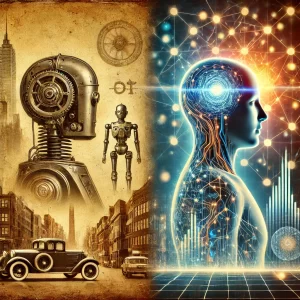Exploring the Spectrum: An Overview of Different Types of AI
Artificial Intelligence (AI) has swiftly evolved from a futuristic concept into a cornerstone of modern technology, infiltrating various sectors with its transformative capabilities. The rapid advancement of AI technologies has led to the development of a broad spectrum of AI types, each with unique functionalities and applications. Understanding these different types of AI is crucial for appreciating the breadth of possibilities that AI offers and the specific roles they play in our daily lives and industries.
### Narrow AI: Specialization at Its Best
Narrow AI, also known as Weak AI, is designed and trained for a specific task. It is the most common form of AI in use today. Unlike humans, who can perform a multitude of tasks, Narrow AI is limited to its predefined functions. This type of AI includes applications such as voice assistants like Siri and Alexa, recommendation algorithms used by Netflix and Amazon, and autonomous vehicles that navigate streets using complex algorithms.
The strength of Narrow AI lies in its ability to process vast amounts of data and perform highly specialized tasks efficiently. For instance, in healthcare, Narrow AI can analyze medical images to identify potential health concerns more quickly and accurately than human practitioners. In finance, it powers algorithms that predict stock market trends or detect fraudulent activities.
### General AI: The Quest for Versatility
General AI, or Strong AI, represents a level of artificial intelligence that matches human cognitive capabilities. Unlike Narrow AI, General AI can understand, learn, and apply its intelligence to solve any problem across various domains, much like a human being. However, achieving General AI remains a theoretical pursuit and a significant challenge for researchers. It would require machines to possess consciousness, emotions, and a comprehensive understanding of the world.
The development of General AI is a double-edged sword. On one hand, it promises groundbreaking advancements in fields like science, medicine, and engineering. On the other hand, it raises ethical concerns about control, employment, and the potential risks of creating machines that surpass human intelligence.
### Superintelligent AI: Beyond Human Capabilities
Superintelligent AI is a step beyond General AI, where machines surpass human intelligence in all aspects, including creativity, problem-solving, and emotional understanding. While still the subject of science fiction, the concept of Superintelligent AI sparks intense debates among scientists, ethicists, and technologists. The potential of such AI systems to drive unprecedented technological progress is matched by concerns about their implications for human society and control.
The theoretical development of Superintelligent AI necessitates careful consideration of ethical frameworks and safety measures to ensure that its capabilities are harnessed for the benefit of humanity, rather than leading to unintended and potentially harmful consequences.
### Machine Learning: The Driving Force Behind AI
Machine Learning (ML) is a subset of AI that provides systems the ability to automatically learn and improve from experience without being explicitly programmed. ML algorithms use statistical techniques to enable machines to improve at tasks with data. It is the driving force behind many AI applications, from voice recognition to predictive analytics.
Machine Learning is divided into various types, including supervised learning, unsupervised learning, and reinforcement learning. Supervised learning involves training a model on a labeled dataset, while unsupervised learning deals with unlabeled data to identify patterns. Reinforcement learning, on the other hand, involves training models to make sequences of decisions by rewarding them for desired actions.
### Deep Learning: Mimicking the Human Brain
Deep Learning, a specialized branch of Machine Learning, involves neural networks with three or more layers. These neural networks attempt to simulate the behavior of the human brain—albeit far from matching its capabilities—allowing it to learn from large amounts of data. Deep Learning has been instrumental in breakthroughs such as image and speech recognition, natural language processing, and autonomous driving.
Deep Learning models require large datasets and significant computational power, often utilizing GPUs to process data efficiently. Their architecture, composed of multiple layers, allows them to extract high-level features from raw input, making them particularly effective in complex tasks such as facial recognition and language translation.
### Natural Language Processing: Bridging Human and Machine Communication
Natural Language Processing (NLP) is a field of AI focused on the interaction between computers and humans through natural language. The ultimate objective of NLP is to enable computers to understand, interpret, and respond to human language in a way that is both meaningful and useful. NLP encompasses a range of tasks, including language translation, sentiment analysis, and chatbots.
NLP has become increasingly important in an era where digital communication is ubiquitous. It powers applications that can analyze social media sentiment, provide customer service through automated chat systems, and even create content using AI-driven language models like GPT-3.
### Robotics: Bringing AI into the Physical World
Robotics is an interdisciplinary field that integrates AI to design, construct, and operate robots. These machines can perform tasks in the real world, ranging from manufacturing and assembly to personal assistance and exploration. AI-powered robots are equipped with sensors and algorithms that allow them to perceive their environment, make decisions, and execute tasks autonomously.
In industries like manufacturing, robotics has revolutionized production lines by improving efficiency and precision. In healthcare, robotic systems assist in surgeries, rehabilitation, and elderly care, providing support and improving patient outcomes.
### Conclusion
The spectrum of AI is vast and continually expanding, with each type offering distinct capabilities and applications. From the specialized tasks of Narrow AI to the theoretical realms of Superintelligent AI, the diversity within AI reflects its potential to transform various aspects of our lives. As we continue to explore and develop these technologies, it is essential to address the ethical and societal implications, ensuring that AI serves as a tool for progress and empowerment, rather than a source of contention and disparity. The journey through the spectrum of AI is just beginning, promising a future where intelligent systems seamlessly integrate into the fabric of everyday life, enhancing our capabilities and expanding our horizons.


